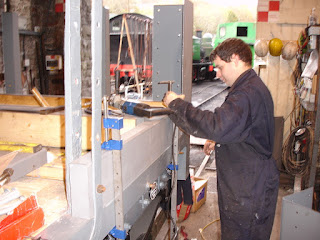Drop Door Hinges
Originally the wagon had two drop doors in the centre section of the floor either side of the central spine. The floors had been rebuilt during the wagon's life and it no longer had the doors when we acquired it, but the lock/release mechanisms for the doors was still in place and Ollie wanted to re-instate the doors.
To do this we needed to make new hinges and fit them, as well as to re-fit the lock/release mechanisms in the new frame.

This photo shows the new hinges in place ready to be cut roughly to length before installing the lock/release levers. The hinges are new steel work, though the pins of 1" diameter bar are very old stock and may well be iron rather than steel.
Before fitting the lock/release mechanism we had to find its ideal location in the length of the frame. I thought this would be centred in the frame but in the event it is offset slightly to one end so that the screws that hold the locking shoe will not foul the tie bars close by.

Once we had determined the position of the shoes we screwed them into place in the underside of the sole-bars.
All was now set to locate and fix the lock/release mechanism. I am always tempted to measure things and then drill holes to locate them, but in this kind of work, where parts are old and worn and even misshapen it is better to proceed by fitting: trying each part in place relative to other components so as to get a better fit.

To get a proper working height for the hinges I ran battens across from the centre spine to the sole-bar and tied up the hinges to them, thus putting the underside of the hinges in the position they'd be in when holding up the door in the closed position.

We then held the locking bar up against the underside of the hinges and with its release lever locked in the locking shoe and marked the positions of the hinge-bolts on the sole bar. We then drilled the holes out and I chiselled the square portion that locates and holds the square end of the hinge bolts.

Here you can see the hinges supported on the release bar. The hinges will be shortened so that when the release bar lever is kicked inwards they will drop past the bar allowing the door to open.

The last job was to apply a little paint to the nuts and washers holding the lock/release mechanism hinges, and then Ollie couldn't resist a trial placing of the wagon's number-plate.



































